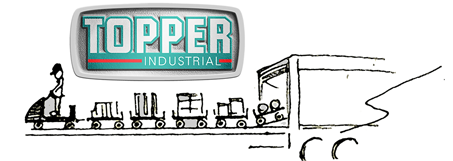Every workplace includes tasks that involve manual materials handling: lifting, lowering, carrying, pushing, pulling, holding, or restraining. When the work exceeds a worker’s physical capabilities, however, serious injuries can result.
Ed Brown, Topper Industrial CEO knows first-hand what makes manual materials handling hazardous. While materials handling is always hazardous, the level of hazard depends on what is being handled, the nature of the task, and the conditions at the workplace or work site.
At ErgoExpo next month, The Topper Industrial team will help attendees examine when the tasks performed are too heavy or in a location too high or low for a safe lift.
 Product being transported may be too big or a shape that makes it difficult to handle. Sometimes product is wet, slippery, or have sharp edges that makes grasping or gripping impossible. Often product is place in a manner that is unstable which can shift the center of gravity because it contains material that can flow, such as water, sand, or a partially filled drum.
Product being transported may be too big or a shape that makes it difficult to handle. Sometimes product is wet, slippery, or have sharp edges that makes grasping or gripping impossible. Often product is place in a manner that is unstable which can shift the center of gravity because it contains material that can flow, such as water, sand, or a partially filled drum.
Brown insists that hazardous tasks for materials handling workers become obvious when poor lifting techniques are used, such as lifting too fast, too often, or too long. Lifting with back bent or while twisting or reach too far is also problematic, such a lifting while sitting or kneeling.
Too often manufacturers attempt to move material over long distances without ensuring appropriate rest breaks driving insufficient recovery time. Many functions are a combination of handling tasks (such as lifting, carrying, and lowering). Even when employees wear clothing that restricts movement or reduces grip strength, it can jeopardize the health and safety of workers.
The working conditions in plants and distributions centers often contribute to hazards of materials handling injuries. Such as walking surfaces that are uneven, sloping, wet, icy, slippery, or unsteady. Differences in floor levels or walking surfaces can also be a hazard.
Topper practices what they preach. Keeping areas of production immaculate, including the canteen for workers, is everyone’s responsibility. Hazards occur because of poor housekeeping causing slips, trips, and falls.
Inadequate lighting, cold, or very hot and humid working conditions, strong wind or gusty conditions also influence safety conditions. Ergonomic industrial equipment addresses materials handling health hazards and avoids injuries.
Workplaces are developing a workforce with the skills needed to identify and control risk factors, including load, tasks, and conditions model, from injury prevention, lifting techniques and exercises to prevent back injuries, mechanical aids, pushing, and pulling.
Topper industrial talks with employers, supervisors, managers, and workers discussing how to reduce injuries associated with materials handling and talking about lean best practices which help to identify when work may be too physically strenuous, and notifying a supervisor about these conditions.
Topper Industrial, the leader in ergonomic and Fork Truck Free material handling equipment, will exhibit at the National Ergonomics Conference and ErgoExpo at Caesars Palace from November 15-18, 2016. Topper Industrial will exhibit at booth 500.
Register to attend: http://ergoexpo.com/register.html
Since 1994, the National Ergonomics Conference & ErgoExpo has been the best place to learn how to build an ergonomics program or maximize an existing program — on any budget, for any industry. Attendees will discover fresh approaches for ergonomics, safety, and wellness programs that will take organization’s productivity and cost-saving measures to the next level.

Article submitted by Jillian Burrow, Marketing Manager for Topper Industrial

